Affiliate disclosure: This post may contain affiliate links. Please see our Privacy Policy.
Jewelweed tincture is often known as the anti-itch herbal remedy! It’s a favorite among plant folk for treating itchy or burning conditions like poison ivy, poison oaks, stinging nettle rash, bug bites, and other types of contact dermatitis or itchy skin conditions. Jewelweed tincture is an essential remedy to have on hand for summer. Thankfully, it’s easy to make at home with just a couple of ingredients.
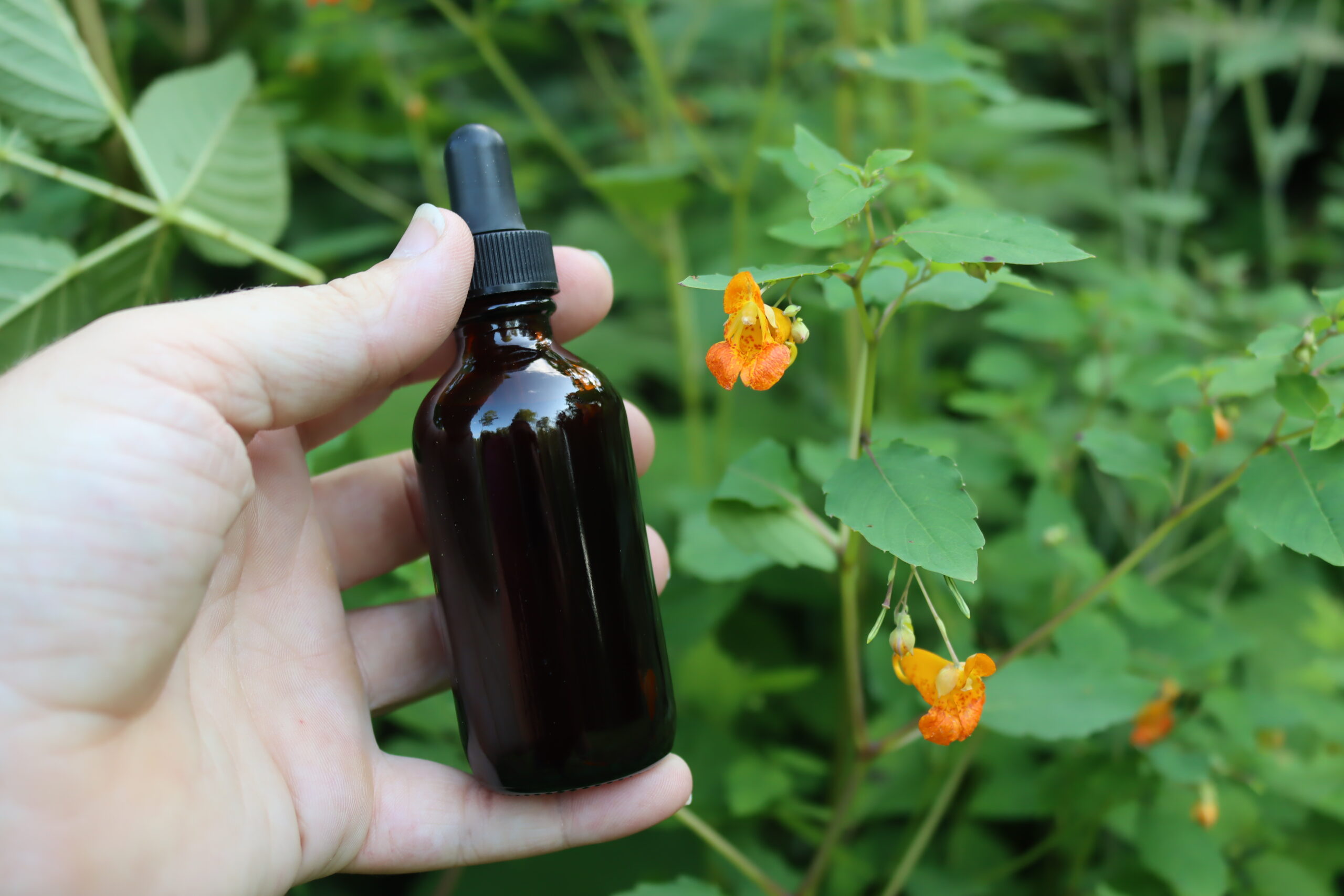
If you ask almost any herbalist about poison ivy, they will immediately tell you about jewelweed. This plant is well known for its antihistamine, anti-inflammatory, anti-fungal, and antipruritic or anti-itch properties, which soothe common skin issues.
Jewelweed tincture is a mild and safe option with no known side effects for external use. Jewelweed contains calcium oxalate crystals. Those with kidney problems, recurring kidney stones, gout, and hyperacidity should avoid taking jewelweed internally. Consult with your physician if you’re unsure whether internal use is safe for you.
Jewelweed is a self-seeding annual that may grow wild in the woods near you. It’s common in much of the eastern and northern United States. Two types are native to the United States: spotted or orange jewelweed (Impatiens capensis) with orange flowers and Pale or yellow jewelweed (Impatiens pallida) with yellow flowers. Other species may be found worldwide.
You can also plant jewelweed from seed. It’s a fun plant because it thrives in moist, acidic soil and dappled light to full shade, where many other flowers will fail to thrive. Keep in mind that you will need to water consistently if you live in an area with drier soils.
You aren’t the only one who will benefit from the jewelweed you plant. This native wildflower is excellent for attracting butterflies, bees, and hummingbirds. Its fun seed pods are also a favorite with young children. When mature, they burst apart at a light touch, earning the plant another common name, “touch-me-not.”
Jewelweed may spread to create large colonies if you have the right conditions. However, this native wildflower is not considered an aggressive spreader and doesn’t spread to the sunny areas we typically use for gardens.
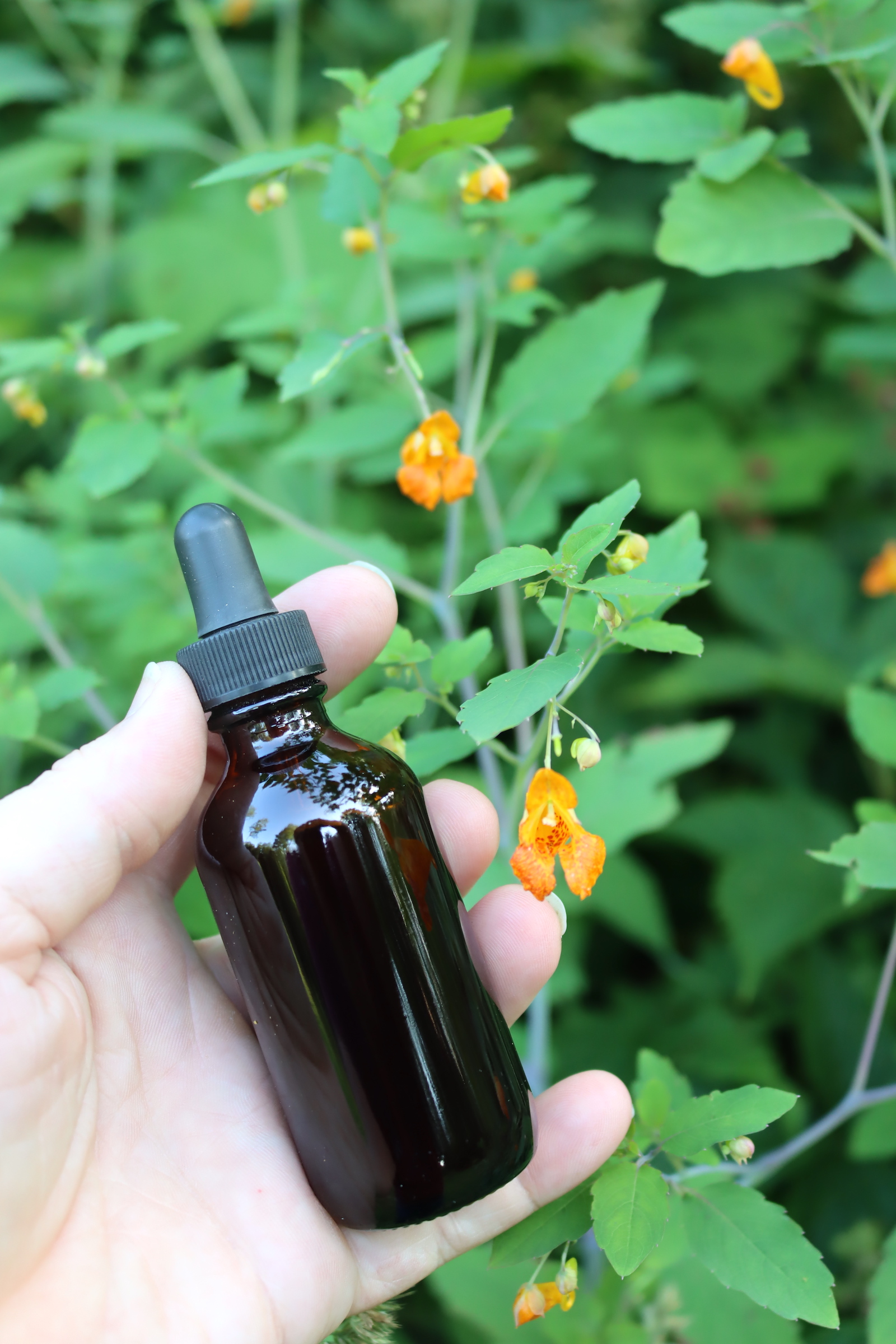
(Always consult your doctor or a clinical herbalist before trying any new herbal remedy, as there’s always the possibility of unintended consequences, allergic reaction, or interactions with other medication. If you’re harvesting wild plant material, make sure you’re 100% confident in your identification and consult multiple sources for your ID. The following is based on my research and experience, but I don’t claim to have any certifications that would qualify me to advise you on your health. Please do your own research and always verify with multiple reputable sources.)
Jewelweed Tincture Uses
Herbalists use jewelweed tincture both topically and internally to treat various ailments.
Topically, jewelweed tincture is used for:
- Treating Poison Ivy, Poison Oak, Contact Dermatitis, and other Itchy Rashes
- Reducing Skin Inflammation
- Treating Skin Fungus and Infections
- Heal Bruises
Internally, jewelweed tincture is used to:
- Treat Mild Digestive Disorders
- Reduce Pain and Swelling
- Treat Rheumatism
Additionally, the herb is currently being investigated for its potential:
- Treating Cancer
- Reducing Menstrual Pain
- Treating Lung Ailments
In these cases, research is ongoing, and more work is needed to establish whether or not the benefits are scientifically significant.
Benefits of Jewelweed Tincture
Jewelweed has a long history of use in herbal medicine. Native Americans, including the Cherokee, Potawatomi, Chippewa, Meskwaki, and Omaha, used it to treat skin irritations and insect bites. Japanese herbalists use a related plant, Balsam (Impatiens balsamina), for the same types of issues.
A couple of Impatiens species also have roles in traditional Chinese medicine. Chinese herbalists have used these plants to treat pain, swelling, rheumatism, and bruises and for vitamin B1 or thiamine deficiency. They also use it for antimicrobial purposes. Additionally, Chinese herbalists have used the seeds for menstrual health to treat post-childbirth pain, coughs, and lung issues.
Today and in the past, jewelweed’s most common use is probably to prevent and treat rashes caused by poison ivy and other plants. Many believe you can avoid the rash entirely if you use jewelweed soon after contacting poison ivy. Most modern studies focus on this usage rather than jewelweed’s use to heal an existing rash.
One 2012 study found that only fresh, mashed jewelweed effectively prevented poison ivy rash. A later 2015 study indicated that this may be due to the saponin content in jewelweed, which, like soap, was effective in preventing poison ivy rash.
Extracts from different Impatiens species have also been shown to be an excellent potential source of antimicrobial agents and antioxidants. A 2017 study found that several species showed good activity against several strains of gram-positive bacteria.
Modern research may also support Jewelweed’s traditional use to treat swelling and rheumatism. A 2016 study found that Balsam (Impatiens balsamina) extract showed significant immunosuppressive activity in rats with induced rheumatoid arthritis and reduced their edema and other arthritis symptoms.
Further study is needed, but some Impatiens species have also shown promising results against specific types of human cancer cells. In a 2015 study, researchers look at Balsam (Impatiens balsamina) extract for treating oral squamous cell carcinoma. They found that it reduced the cancer cell’s viability and induced cell death, making this plant a potential option for future cancer research and treatment.
If jewelweed is taken internally as a tincture, it has a diuretic effect and is thought to soothe digestive issues. There is currently no research to back up this purported usage and care should be taken if using other medications that are affected by excessive urination.
Jewelweed tincture doses vary based on your intended usage. For external use, spray or dab it onto the affected area with a clean cotton swab as needed to relieve itching and discomfort. For internal use, take one dropper of jewelweed tincture up to 3 times daily. Don’t continue use for more than one week.
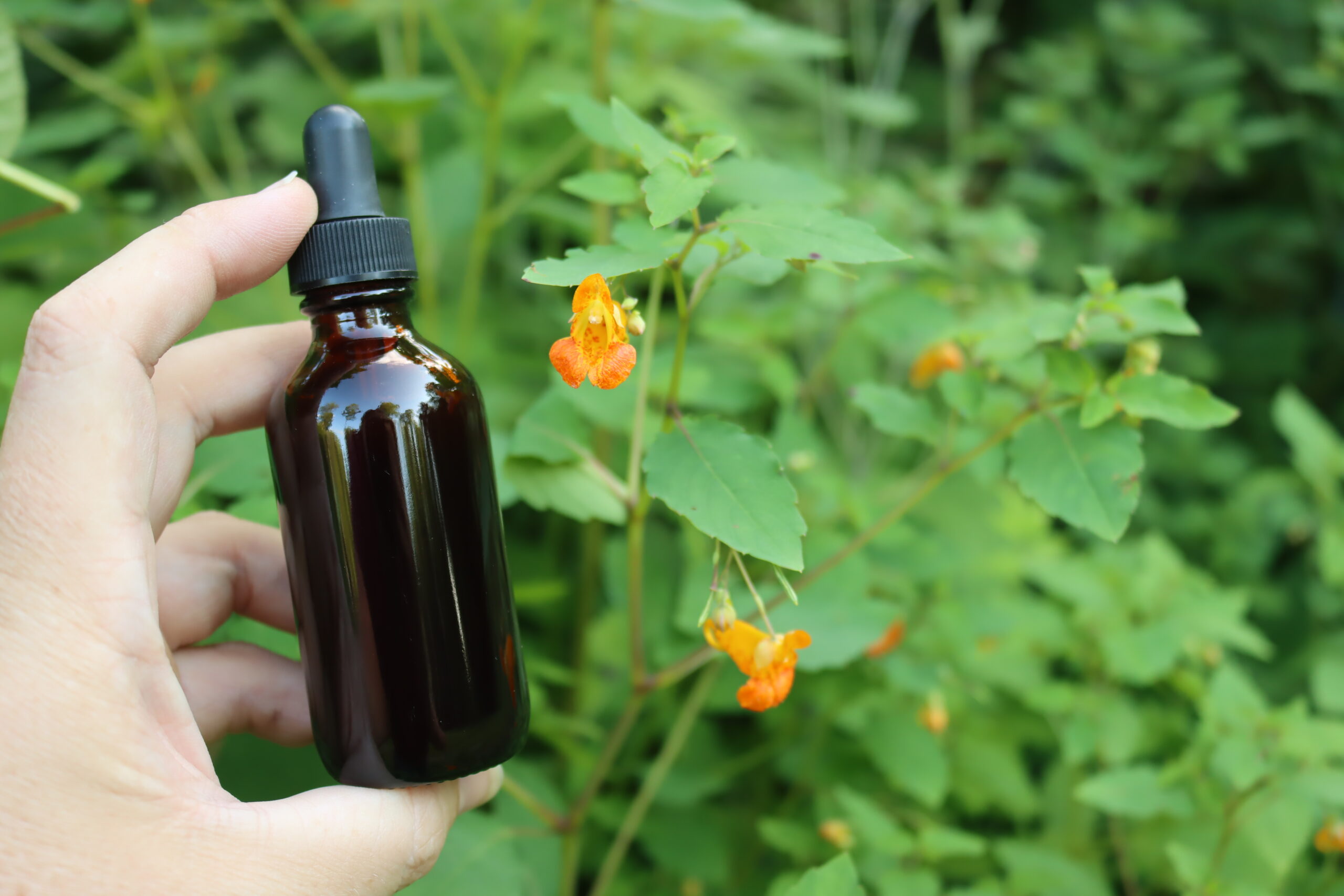
Parts Used for Tincture
To make a jewelweed tincture, you will probably need to find or grow it. It’s not often available commercially. Fresh jewelweed is best, but you can also use jewelweed that you have previously dried or frozen, though your tincture may not be as effective.
To prepare your jewelweed, gather all the aerial parts of the plant, including the stems, leaves, and flowers. Then, roughly chop them up. This increases their surface area, allowing them to absorb the alcohol effectively for your tincture.
How to Make Jewelweed Tincture
To make a jewelweed tincture, you’ll need the following ingredients and equipment:
- Fresh, dried, or frozen jewelweed
- Vodka* (or any other palatable alcohol that’s at least 80 proof/40 percent — you don’t have to choose anything expensive, and you can use whatever suits your taste)**
- One-pint mason jar with lid (amber glass is ideal, but as long as you keep the tincture away from light at all times, it won’t make a difference)
- Funnel
- Cheesecloth
- Fine mesh sieve
- Amber glass tincture bottles (with dropper)
*The Herbal Academy’s tincture-making course specifically recommends using 40 to 60% alcohol when working with most dried herbs and 70 to 95% alcohol when working with most fresh herbs. Jewelweed is sometimes considered a mucilaginous herb, which they sometimes recommend as low as 25% alcohol, but it does have some alcohol-soluble constituents.
**Never use isopropyl/rubbing alcohol for tinctures (or any other remedy you plan on ingesting). Even in small amounts, this type of alcohol is toxic and meant for external applications only.
To make a jewelweed tincture, fill your mason jar about ⅔ full of fresh jewelweed or frozen jewelweed or about ½ full of dried jewelweed.
Cover the jewelweed with the alcohol of your choice, making sure it is all submerged as best as possible. Then, seal your jar with an airtight lid.
At this point, your tincture will need time to develop. Keep it somewhere cool and dark, away from direct sunlight. Gently shake your jar once a day. It will be fine if you miss a couple of days.
After about 4 to 6 weeks, it’s time to decant the tincture.
Line a funnel with a few layers of cheesecloth and strain your tincture through it and into another jar. If your tincture is still very cloudy or has a lot of particles floating in it, you can let it settle and strain it again through a fine screen or cloth.
Then, pour your tincture into tincture bottles or spray bottles for storage and use. Label each of these bottles with the name, date, and dosage. I like to use simple masking tape and a marker to make my labels, as they peel off easily when it’s time to re-use the bottle.
Jewelweed Tincture Dosage
I’d suggest consulting a clinical herbalist for an exact dosage specific to your body and needs.
Jewelweed tincture is primarily used as a topical treatment. You can use the tincture as a spray or apply it with a cotton swab or clean piece of cloth or gauze. Jewelweed has no known side effects for external use, so you can safely use it as needed to decrease discomfort and itching related to different skin conditions.
For internal use, take a dropper full of jewelweed up to three times per day.
Jewelweed Formulations
Jewelweed is often combined with other soothing, anti-inflammatory herbs that can help combat itchiness, burning, and other skin symptoms. Good options include calendula tincture, chamomile tincture, turmeric tincture, and aloe vera. If you’re treating a bacterial issue, you may consider pairing it with other antibacterial herbs like oregano.
If you’re interested in the science behind combining herbs to enhance their effectiveness, I’d recommend taking this online course in Mastering Herbal Formulations from the Herbal Academy. It covers the science of blending herbs into homemade formulations in detail.
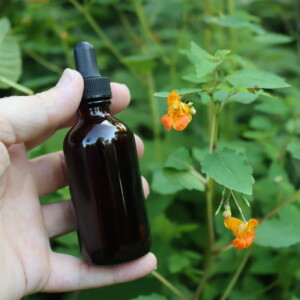
Jewelweed Tincture
Equipment
Ingredients
- Jewelweed freshly harvested
- Neutral Spirit such as vodka*
Instructions
- Begin by filling a clean mason jar about three-quarters full with freshly harvested jewelweed.
- Pour enough alcohol over the jewelweed to completely cover the plant material. Make sure all the plant matter is submerged in the liquid.
- Tighten the lid securely on the jar and give it a gentle shake to mix the contents. Store the jar in a cool, dark place for 6 to 8 weeks, allowing the alcohol to extract the beneficial properties from the jewelweed.
- Shake the jar lightly every few days to help with the extraction process and ensure even soaking.
- Check the alcohol level periodically. If the plant material rises above the liquid, top it off with more alcohol to keep it fully covered.
- After the infusion period, prepare to strain the tincture by lining a funnel with cheesecloth and placing it over the neck of a dark amber glass bottle. Slowly pour the tincture and jewelweed mixture into the funnel, pressing the plant matter gently to extract all of the liquid into the bottle.
- Label your finished tincture with details such as its contents, the date it was made, recommended dosage, and possible uses. Store it in a cool, dry place, away from sunlight to maintain its potency.
Notes
Disclaimer on Homemade Herbal Remedies
I’ve been foraging wild medicines and treating my family with herbal remedies for the past 20 years, but I’m self-taught. Be aware that I am not a clinical herbalist, and this is based on my own research and personal experience using medicinal plants. I do not claim to have the experience that’d qualify me to advise you on your health, and I’m only providing this as a reference to encourage a broader interest in medicinal plants.
Please use this as a jumping-off point, but always do your own research and verify anything you read with multiple sources.
It’s always possible to have an adverse reaction to any medicinal herb, and plenty of people are allergic to even gentle herbs like chamomile. Always consult your doctor or a certified herbalist before trying any new medicinal plant. Often, they can have unintended reactions in combination with other herbs and supplements, and many herbs have side effects even when they are effective for their intended purpose.
If you are seriously interested in herbal medicine, I’d suggest investing in a course in herbal medicine, and I’d recommend any of the online courses put out by the Herbal Academy of New England. Specifically, the introduction to herbal medicine course and the family herbalist group of courses.
They also have a mushroom course, covering both medicinal and edible mushrooms, and a Botany and Wildcrafting Course. I’ve taken both and they’re informative, inspiring, and artfully presented.
Herbal Tinctures
Interested in making other homemade herbal tinctures?
- Yarrow Tincture
- Chickweed Tincture
- Elderberry Tincture
- Dandelion Tincture
- Burdock Tincture
- Echinacea Tincture
Herbal Medicine Making
Herbal medicines don’t stop at tinctures! Learn how to make more homemade medicine…
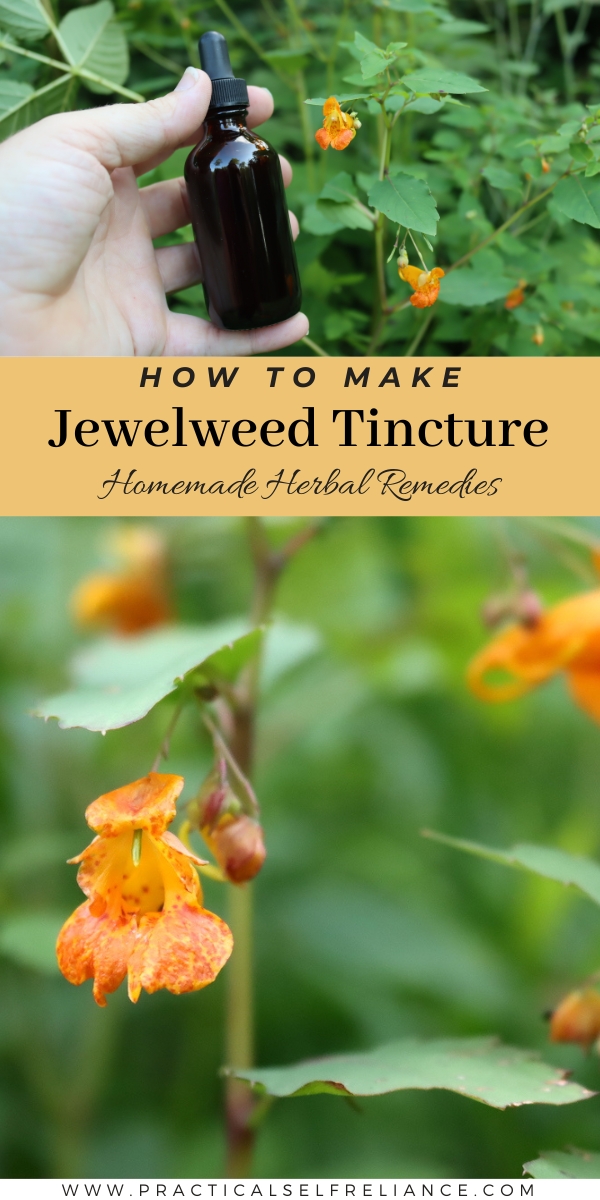
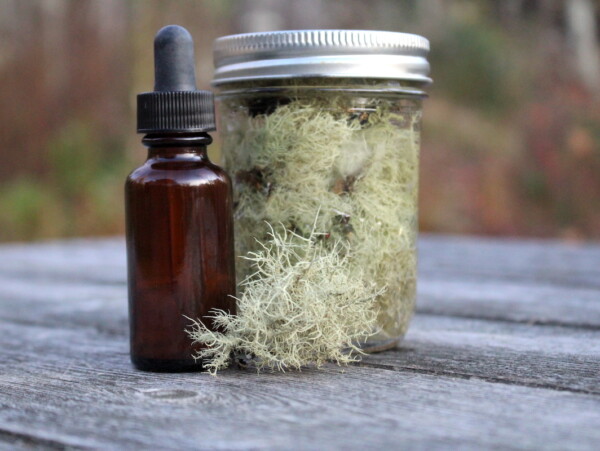
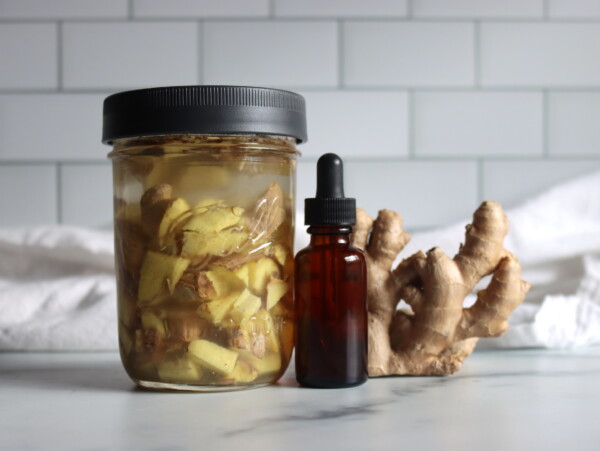
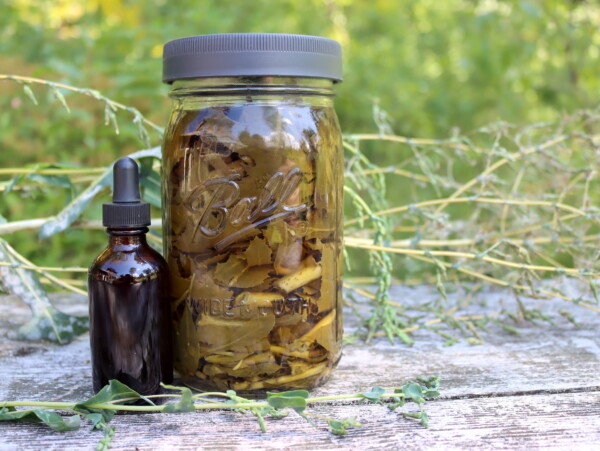
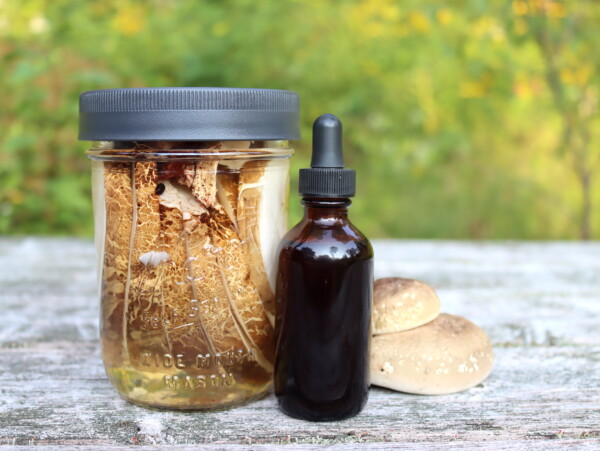
Hi!
i love your content but do you have a way for me to pay you for PDFs so i can combine all of the herbalism and other plant recipes into a kind of reference book? weird questions yes but its SO hard to find good information like this that is practical!
I understand that. Unfortunately we are not able to create PDF’s at this time.